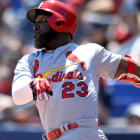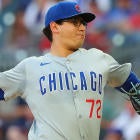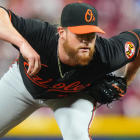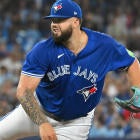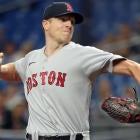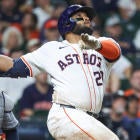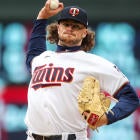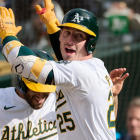For more Fantasy baseball insights, and to keep up with all the latest news, roster trends and more throughout the season, subscribe to Fantasy Baseball Today now on iTunes, Stitcher or Spotify. You can find us on YouTube now, with full episodes and clips available every Monday through Friday.
Disclaimer: I don't often change my mind about anyone this time of year.
I may say one player is showing clearer signs of meeting his upside than another. I may point to underlying trends that could manifest as something more. But when it comes to making a true about-face ... it's too early for that. I know there will come a point when you tire of me saying it, but it's true. When we refer to notoriously slow starters, we're usually referring to what they do in April, so it follows logically that anything that's out of sync in April is just a slow or fast start. Or it might be, anyway.
So when I say I'm already wrong about something I believed coming into the year, understand it comes from a place of deep patience, reflection and perspective. And act with according confidence, whether it means making a trade or punting on a particular player.
What follows are 16 statements (paraphrased, of course) that I made somewhere this spring, whether in a column or on the Fantasy Baseball Today podcast, and why I no longer believe them to be true.
Elvis Andrus is washed up and a waste of a mid-round pick.
He's a 30-year-old shortstop whose numbers declined drastically across the board last year. Maybe he deserved a pass for coming back from a fractured elbow, but where did the stolen bases go? Hard to blame an elbow for that. Now, though, it's like he picked up where he left off in 2017 — power boost, steals and all — and there's a clear enough track record of success that I'm fully back on board.
Cody Bellinger's downside outweighs the upside at his going rate.
He ended 2018 as a platoon player (really, he was out of the lineup for 13 of the Dodgers' final 14 games against lefties) whose power production no longer seemed like a sure enough bet to elevate him to early-round status, and while I recognized the upside, I presumed the most likely scenario was something similar to what we saw last year, only with the added playing-time concern. Well, it looks like Bellinger is delivering his best-case scenario instead, not only reclaiming his lineup spot against lefties but cutting way down on his strikeouts, making the quality of contact reserved for the game's elites and putting his speed to use on the base paths. He looks like a genuine first-round type.
Matthew Boyd doesn't have the potential some analysts would have you believe.
Boyd was hyped in some corners of the Fantasy Baseball world, and I didn't get it, presuming he had maxed out his strikeout potential while revealing a clear vulnerability to the long ball. What I didn't expect was that he'd take the Patrick Corbin route to success, making his slider his lead pitch while more or less eliminating the ones that got him into trouble, namely the changeup and curveball. And as with Corbin last year, the strikeout rate has exploded.
Matt Chapman is fine but probably not getting any better from here.
In a development that I'm halfway suspicious has something to do with the quality of the pitching the Athletics have faced so far, seeing as other members of their lineup are doing similar things, Chapman's strikeout rate has drastically improved from league average to Michael Brantley level, which rips to shreds all of my assumptions about his upside. And while I'm skeptical it can continue at quite this level, the change is too drastic for me to think he'll go back to striking out a quarter of the time. Even at a deep position, he may have top-five potential.
The Yandy Diaz truthers are oversimplifying the whole exit velocity thing.
The case for Diaz went like this: He hits the ball incredibly hard, so if he'd just hit it high, he'd certainly hit it far. It seemed a little too easy to me, like we shouldn't expect his exit velocity to remain intact if he began jiggering with the launch angle. So far, though, it's played out swimmingly. He has quintupled his career home run total — and with only a slight improvement in fly-ball rate. If he can muscle 20 over the fence, along with his contact skills and plate discipline, he'll be more or less must-start in Fantasy.
Edwin Encarnacion's decline is so well established by now that he may just drop off a cliff this year.
His strikeout rate spiked last year after steadily rising the past three years. His walk rate dropped at the same time. He'd be playing in a pitcher's park for the first time, and with a club that had announced its intentions to rebuild. It just seemed like things might unravel quickly for the 36-year-old. Instead, Encarnacion has turned back the clock on both the strikeout and walk rate while the lineup around him has proven to be productive. What's especially encouraging about his performance so far is that he's a notoriously slow starter, batting .238 with a .752 OPS for his career in March/April.
Garrett Hampson's home park gives him little downside and makes him an ideal sleeper target for steals.
It feels like it backfires every time I make this case for a non-slugger at Coors Field, and yet I keep going back to it because ... well, look at DJ LeMahieu's career. The park inflates BABIP in a way that should greatly benefit anyone who puts bat to ball. Hampson's problem is that he hasn't done it anywhere close to how he did in the minors. He hasn't walked like he did in the minors. He hasn't run like he did in the minors. And if he keeps it up, he's going to wind up back in the minors. His window to establish himself as a regular part of the lineup ended Thursday with Ryan McMahon's return from the IL.
Jason Heyward is no longer deserving of our attention and probably wouldn't have a job if not for his contract.
Pay careful attention to the wording of this particular take, because I don't mean to suggest it's inclusion here confirms Heyward is awesome again. But I've found myself adding him in most every league where he's available because it'd be so convenient if he was. It doesn't exactly stretch the limits of plausibility either given that he's a former Fantasy prize still on the right side of 30, and his launch is greatly improved so far. Maybe it's just a product of sample size, but if there's 20-20 potential to go along with a high contact rate, yeah, that's deserving of our attention.
Kenley Jansen's diminished stuff has him teetering on the verge of disaster.
After a worrisome start, it ended up being only a small drop in velocity for Jansen last year, but that drop permeated his numbers so completely, bringing him down to mortal level so quickly, that I couldn't help but wonder what might happen if his skills diminished further, as seemed to be happening in spring training. Well, so far, the velocity is actually down a little from last year, but pretty much all the ratios are a tick up. So ... whatever. He is closer to mortal than during his heyday, but he's still money.
Austin Meadows could have a breakout season, I guess, but what kind of upside are we talking, really?
For all the hype, Austin Meadows didn't deliver much as a prospect, making contact at a high rate but in a way that didn't really amount to much, and then after an initial power surge following his call-up last year, he quickly came back down to earth. Well, between him, Diaz and, shoot, Tyler Glasnow, I'm coming to the understanding that when the Rays trade for someone, it's for good reason. While it's still not totally clear how much he'll play against lefties, nothing Meadows is doing right now raises a red flag for me, not with the improved fly-ball and hard-hit rates. He doesn't strike out much. He hits the ball to all fields. He looks like a genuine hitting specimen — and with some speed to boot.
Even in a timeshare with Austin Hedges, Francisco Mejia will hit enough to matter at a position where most everyone's playing time is in question.
Two things: I expected the timeshare to be closer to 50/50 than 67/33. and I expected Mejia to actually hit. Hard to say whether the 4-for-28 start owes something to the sparse playing time, but at this point, it's more likely to get him sent down than to put him in the lineup more. Needless to say, I've moved on for now, and unless something goes terribly wrong for Hedges, I don't see 2019 being Mejia's year.
Two years ago was the aberration, and Marcell Ozuna is actually not so great.
It's still possible Ozuna's 2017 was an aberration in that it was built on a high BABIP. His truer best self may be more reliant on the long ball, but it doesn't look like those are going to be in short supply this year. The Ozuna we saw over the final four months last year — the one who hit .290 with 20 homers and an .816 OPS in 98 games, despite contending with a shoulder issue — seems closer to the one I expect we're going to get now, maybe trading off some of the batting average for more home runs.
David Peralta only had the year he had because of an outlier hard-hit rate that he couldn't possibly repeat.
... Yet here it is almost identical to the 48.6 percent rate that ranked second among all qualifying batters last year. Of course, even if we assume that's the new normal for him, it's still not an open-and-shut case. My assumption was that the outlier hard-hit rate was mostly responsible for the outlier home run-to-fly ball rate that saw him up his career high from 17 home runs to 30, and that rate is indeed back to normal. Still, there's more reason for hope than I would have expected three weeks in.
Domingo Santana will struggle to find consistent playing time and probably never recapture the magic from 2017.
Maybe he set the ball in motion by hitting a grand slam in that first game in Japan or maybe it was the plan all along, but the Mariners have shown no interest in spelling Santana, sitting him just one time as a way to keep a red-hot Daniel Vogelbach in the lineup. And Santana has only continued to do things right since that first game, cutting down on the strikeout rate that was such a concern during his 30-homer, 15-steal 2017 while continuing to demonstrate a high-BABIP profile with elite line-drive and hard-hit rates. He also walks, so there isn't much separating him from Tommy Pham right now other than perceived risk.
Matt Strahm is going to take the stuff he showed in the bullpen with him to the starting rotation.
The way the Padres sold it this spring, his varied arsenal was wasted in relief — where he had a 2.05 ERA, 0.98 WHIP and 10.1 strikeouts per nine innings last year — and would play better in a starting role. And with the way he dominated this spring, I bought it hook, line and sinker. What I didn't account for was the corresponding drop in velocity, which has neutered his best two pitches, the fastball and slider, making him no sort of bat-misser. Maybe there's more to it than that, but as things stand now, I'm rooting for Strahm to go back to the bullpen.
Tyler White is the obvious choice to claim the DH at-bats forfeited by Evan Gattis and an exciting sleeper.
I mean, he already started taking them from Gattis down the stretch last season, putting together an .888 OPS that was backed up by his minor-league production. And once it was clear Kyle Tucker wasn't making the major-league roster, what else were the Astros going to do? I apparently didn't account for how much they liked Tony Kemp or how much they liked the idea of using the DH spot to give their star players time off from the field. White has started just eight of the Astros' first 18 games and is probably a forgotten man once streaking prospect Yordan Alvarez gets the call.













